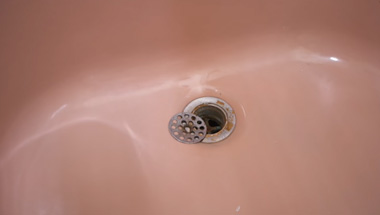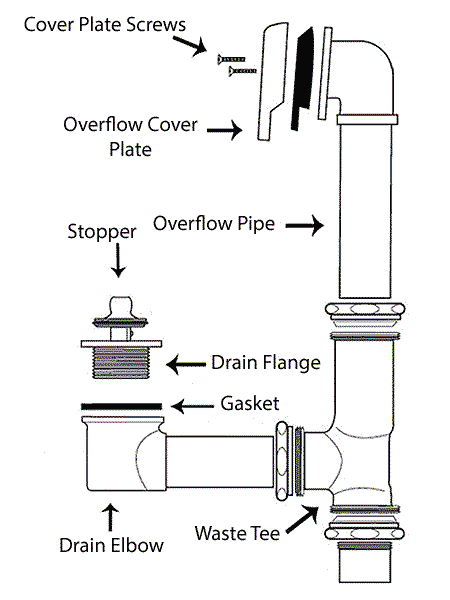A tub drain generally removes the wastewater from the bathtub and needs to be temperature-stable and corrosion-resistant. Hence, the quality of a suitable tub drain will depend on its material.
So, Brass vs. PVC tub drain, which one to pick?
If you consider Brass vs. PVC tub drains, the latter is cheaper and easy to install than the first one. But the brass will be more stable, durable, and eco-friendly as a tub drain material than the latter one.
In this article, we will discuss the advantages, disadvantages, and maintenance of these two drain materials. After reading this article, you will learn which is better and how to replace it properly. So, without further ado, let’s start.

Brass Tub Drains
Brass is a zinc-copper alloy and is softer than steel. Generally, people consider this material as a bathtub drain’s gold standard.
Advantages Of Brass Tub Drains
Brass as a tub drain material will provide several advantages, such as:
- The zinc content in the material act as anti-resistant and will resist corrosion
- Prevents buildup of various types of microorganisms
- It’s pretty durable
- It is stable with the change in water temperature
- You can find two types of brass such as yellow and red. The red one is more flexible as it contains more copper content
Disadvantages Of Brass Tub Drains
Along with the multiple advantages, you may encounter a few disadvantages of brass tub drains too. Those are:
- The installation is quite tricky, and you will need experienced labor for the proper installation
- Brass might undergo dezincification if the water becomes slightly alkaline or acidic. This may cause discoloration of the natural color of the material
- As the dezincification will reduce the amount of zinc, it will weaken the material. As a result, it will cause damage or breakage in the drain pipe eventually
Maintenance Tips For Brass Tub Drains
Without proper maintenance, the quality of the brass tub exhaust may deteriorate. Hence, follow these methods for keeping the drains in good condition:
- Clean the tub drain often with warm soap and water
- Apply nickel plating on it for long-lasting and additional protection against corrosion
- And to restore the corroded brass drain, you need to polish the drain
- You must wash the drain carefully and then apply the brass polish
- Then, buff out any visible film from the material
- Next, you have to apply brass sealer on the drain evenly
- After drying correctly, you can put the drain back on the tub
PVC Tub Drains
PVC is a material that is made of polyvinyl chloride. Generally, this material is highly applicable and recommended for cold water applications. Let’s know more details about these PVC drains:
Advantages Of PVC Tub Drains
If you choose a PVC drain for your bathtub, you will get various benefits. Those are:
- PVC is a flexible and lightweight material
- Installation process is relatively straightforward
- Because of their smoothness, PVC won’t cause agglomeration of slime
- PVC drains are inexpensive
- Long-lasting corrosion resistance
Disadvantages Of PVC Tub Drains
Though PVC drains have a lot of advantages, there are also possibilities that you will encounter several drawbacks. Those drawbacks are:
- The impact resistance of the PVC material will diminish with the decreasing temperature, and it may show much brittleness
- The PVC drain will expand with the increasing temperature of the water. Eventually, the fitting of the drain with the drain pipe will get loosen
Maintenance Tips For PVC Tub Drains
We will mention several tips for the proper maintenance of PVC drains:
- Avoid any physical impacts on this system
- For cleaning, always use warm water instead of boiling water
- Never use chlorine or any chlorinated cleaner, as it can cause corrosion in this drain
- Clean it using any non-abrasive cleaning agent such as dish soap, and water
Brass vs. PVC Tub Drains: Which One Is Better
Generally, when choosing between Brass or PVC, you must consider factors like cost, durability, corrosion resistance, installation process, etc. The table below presents a quick comparison between these two.
| Factors | Brass Tub Drains | PVC Tub Drains |
| Cost | Costly than PVC drains | Relatively cheap |
| Durability | Long-lasting | Less durable |
| Corrosion resistance | Can’t provide long-lasting corrosion resistance | Provide corrosion resistance forever |
| Installation process | Difficult and tricky | Simple |
| Stability | More stable in all water temperature | Unstable with water temperature variations |
| Eco-friendly | More eco-friendly | Not eco-friendly |
Here is a detailed discussion of the above table:
Cost
Brass tub drain assembly will cost around $100-$150, whereas you can get PVC one at only $20-$50. Besides, for installing a brass one, you may need to pay around $350 for skilled labor.
However, you can install it with the help of less-skilled labor at a lower cost than the previous one. Also, you can install the PVC tub drain assembly yourself with a DIY route, costing $0. So, if you are looking for a budget-friendly option, PVC tub drains will be a better choice.
Durability
Brass materials are more robust against any physical impact. That’s why it’s more durable than PVC drains. So, you better choose brass material over PVC for an exposed drain assembly.
Corrosion Resistance
You must apply an additional nickel coating on the brass material to make it corrosion-resistant in the long term. So, to avoid this extra work, choose PVC, as it won’t need any additional coating for corrosion resistance.
Installation Process
To install the brass drain, you must look for specialized and experienced labor. But you can install a PVC drain even with less skilled labor.
Stability
The brass material has higher stability over different ranges of water temperature. But the PVC drain will become brittle with the drop in water temperature. Besides, the material will also expand if the water temperature becomes higher.
Eco-friendly
The brass material is more eco-friendly than the PVC material. Researchers consider the latter as harmful material to the environment. Because its production and recycling can produce toxic fumes due to its high chlorine content.
In the recycling process, the composition of the brass remains almost similar. That’s why it’s sustainable and also doesn’t cause any harm to the environment.
How To Replace A Tub Drain?
For picking the proper replacement tub drain, you must consider the following:
- Tub height
- Drain shoe measurements
- Drain hole size
- Coordination of the tub drain with the other finishes in your bathroom
- The installation and maintenance difficulty
- Durability
- Costs
Procedures For Replacing Tub Drain
For this replacement process, you will need some tools, such as:
- A drain key
- Flathead screwdriver
- Putty
- New drain assembly
- Pliers
- Rubbing alcohol
Here is a step-by-step guide for replacing a brass or PVC tub drain:
- Step 1: Take out the two screws of the overflow plate with a screwdriver
- Step 2: Pull out the drain pipe and turn it counterclockwise with pliers
- Step 3: Now, you can easily pull out the foot lock stopper
- Step 4: Remove the linkage rod, plunger, overflow plate, and drain plate
- Step 5: Use the drain key to remove the old drain flange
- Step 6: Then, take out all the old putty. You can apply to rub alcohol on it if you find difficulty in removing it
- Step 7: Place new putty around the flange perimeter
- Step 8: If you have a rubber gasket with the drain assembly, put it around the drain
- Step 9: Put the new drain flange inside the rubber gasket and tighten it using the drain key
- Step 10: Connect the bathtub drain stopper with the flange by slightly turning it clockwise
- Step 11: Push the linkage and plunger of the lever drains into the overflow pipe
- Step 12: To check leaks, close the drain stopper and fill the bathtub with water. Let it be like this for a few hours and check if the water level is in the same condition
- Step 13: If the water level decreases, you need to check and reseal the leakages and gaps again
Check out this picture to understand the overall arrangements of the tub drain assembly better:

Cautious While Replacing Tub Drain
Here are a few common mistakes to avoid when replacing a tub drain:
- Old putty may cause gaps or leakage in the drain system. That’s why you better not use old putty on the threads
- You need to seal the threads with pipe sealant to prevent leakage
- Make sure you are not tightening the rubber gasket seals too excessively as it will displace the seal
- You shouldn’t use putty between the face of the tub and drain ring instead of around the thread tops
Conclusion
The material of the tub drains plays a vital role in durability, stability, and ease of maintenance. In this article, we discussed the Brass vs. PVC tub drain comparison. Normally, PVC won’t rust like brass ones and will cost less to buy and install.
Yet, brass material is more durable and stable than PVC material. Though the replacement process of a tub drain seems easy, silly mistakes can damage the drain assembly. So, be careful.